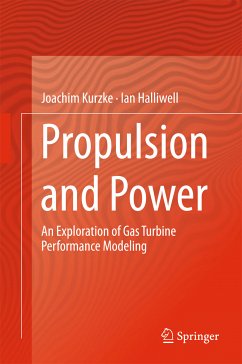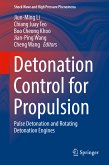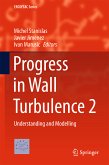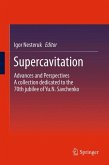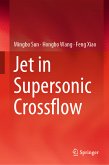Joachim Kurzke, Ian Halliwell
Propulsion and Power (eBook, PDF)
An Exploration of Gas Turbine Performance Modeling
136,95 €
136,95 €
inkl. MwSt.
Sofort per Download lieferbar

68 °P sammeln
136,95 €
Als Download kaufen

136,95 €
inkl. MwSt.
Sofort per Download lieferbar

68 °P sammeln
Jetzt verschenken
Alle Infos zum eBook verschenken
136,95 €
inkl. MwSt.
Sofort per Download lieferbar
Alle Infos zum eBook verschenken

68 °P sammeln
Joachim Kurzke, Ian Halliwell
Propulsion and Power (eBook, PDF)
An Exploration of Gas Turbine Performance Modeling
- Format: PDF
- Merkliste
- Auf die Merkliste
- Bewerten Bewerten
- Teilen
- Produkt teilen
- Produkterinnerung
- Produkterinnerung

Bitte loggen Sie sich zunächst in Ihr Kundenkonto ein oder registrieren Sie sich bei
bücher.de, um das eBook-Abo tolino select nutzen zu können.
Hier können Sie sich einloggen
Hier können Sie sich einloggen
Sie sind bereits eingeloggt. Klicken Sie auf 2. tolino select Abo, um fortzufahren.

Bitte loggen Sie sich zunächst in Ihr Kundenkonto ein oder registrieren Sie sich bei bücher.de, um das eBook-Abo tolino select nutzen zu können.
Guide for solving real world problems with modern computer software
Good text for teaching gas turbine design and performance
Solutions of overall system simulation problems
- Geräte: PC
- ohne Kopierschutz
- eBook Hilfe
- Größe: 45.51MB
Andere Kunden interessierten sich auch für
![Propulsion and Power (eBook, PDF) Propulsion and Power (eBook, PDF)]() Joachim KurzkePropulsion and Power (eBook, PDF)160,95 €
Joachim KurzkePropulsion and Power (eBook, PDF)160,95 €![Detonation Control for Propulsion (eBook, PDF) Detonation Control for Propulsion (eBook, PDF)]() Detonation Control for Propulsion (eBook, PDF)136,95 €
Detonation Control for Propulsion (eBook, PDF)136,95 €![Progress in Wall Turbulence 2 (eBook, PDF) Progress in Wall Turbulence 2 (eBook, PDF)]() Progress in Wall Turbulence 2 (eBook, PDF)72,95 €
Progress in Wall Turbulence 2 (eBook, PDF)72,95 €![New Results in Numerical and Experimental Fluid Mechanics XI (eBook, PDF) New Results in Numerical and Experimental Fluid Mechanics XI (eBook, PDF)]() New Results in Numerical and Experimental Fluid Mechanics XI (eBook, PDF)160,95 €
New Results in Numerical and Experimental Fluid Mechanics XI (eBook, PDF)160,95 €![Supercavitation (eBook, PDF) Supercavitation (eBook, PDF)]() Supercavitation (eBook, PDF)72,95 €
Supercavitation (eBook, PDF)72,95 €![Elements of Vorticity Aerodynamics (eBook, PDF) Elements of Vorticity Aerodynamics (eBook, PDF)]() James C. WuElements of Vorticity Aerodynamics (eBook, PDF)72,95 €
James C. WuElements of Vorticity Aerodynamics (eBook, PDF)72,95 €![Jet in Supersonic Crossflow (eBook, PDF) Jet in Supersonic Crossflow (eBook, PDF)]() Mingbo SunJet in Supersonic Crossflow (eBook, PDF)72,95 €
Mingbo SunJet in Supersonic Crossflow (eBook, PDF)72,95 €-
-
-
Guide for solving real world problems with modern computer software
Good text for teaching gas turbine design and performance
Solutions of overall system simulation problems
Good text for teaching gas turbine design and performance
Solutions of overall system simulation problems
Dieser Download kann aus rechtlichen Gründen nur mit Rechnungsadresse in A, B, BG, CY, CZ, D, DK, EW, E, FIN, F, GR, HR, H, IRL, I, LT, L, LR, M, NL, PL, P, R, S, SLO, SK ausgeliefert werden.
Produktdetails
- Produktdetails
- Verlag: Springer International Publishing
- Seitenzahl: 755
- Erscheinungstermin: 28. Mai 2018
- Englisch
- ISBN-13: 9783319759791
- Artikelnr.: 56813920
- Verlag: Springer International Publishing
- Seitenzahl: 755
- Erscheinungstermin: 28. Mai 2018
- Englisch
- ISBN-13: 9783319759791
- Artikelnr.: 56813920
- Herstellerkennzeichnung Die Herstellerinformationen sind derzeit nicht verfügbar.
Joachim Kurzke spent his engineering life dealing with gas turbine performance, first at the Technical University of Munich, Institute for Flight Propulsion.
1976 Kurzke joined the performance department of the company which is now MTU Aero Engines and stayed there for 28 years. He worked on a multitude of different engine projects, designed the engine performance program MOPS for MTU, and applied it to the everyday problems in the performance department.
MOPS is due to the modular design very flexible and can be adapted easily to new requirements, however, it's use requires significant training in gas turbine performance. This observation resulted in the development of the performance program GasTurb(TM). This software concentrates on the user interface, without neglecting any detail which is required for professional gas turbine performance work. After more than 20 years in the public domain, GasTurb(TM) is well known and acknowledged all over the world.
Kurzke has published numerous papers dealing with gas turbine performance, and was a member of several RTO (former AGARD) working groups, as well as the SAE E33 committee "Thrust in Flight". He is still a member of the ASME/IGTI Aircraft Engine and Education Committees.
Ian Halliwell obtained his B.Sc. in Aeronautical Engineering and M.Sc. in Aerodynamics from Imperial College, London, followed by a Ph.D. in Experimental Gas Dynamics from the University of Southampton. His professional career began in 1975 at Rolls-Royce, Derby in Turbine Aerodynamics Research. He then crossed the Atlantic to work for Pratt and Whitney Canada in Mississauga and subsequently GE in Cincinnati, where he moved into the preliminary design of complete engine systems and spent a few years on the High Speed Civil Transport program. During that period, he also began teaching in GE after-hours education.
While continuingto model complete engine systems, his teaching activities continued after moving to the small business world, as a contractor at the NASA Glenn Research Center and expanded through involvement with AIAA and ASME/IGTI. He chaired the AIAA Air Breathing Propulsion and Gas Turbine Engine Technical Committees and is still an active member of AIAA. He is also a member of the ASME/IGTI Aircraft Engine and Education Committees. His connection to students and university faculty was enhanced during the 14 years he organized the AIAA International Engine Design Competition for undergraduate teams. He met Joachim Kurzke while presenting a tutorial on Preliminary Engine Design at ASME TurboExpo in 2001 and the seeds were sown for this book a few years later.
His current special interests are in new engine architectures, involving vaneless counter-rotation and exoskeletal architectures for compressors and turbines - both axial and radial. The past 10 years or so, back in aerodynamics, involved the development and application of new design tools.
1976 Kurzke joined the performance department of the company which is now MTU Aero Engines and stayed there for 28 years. He worked on a multitude of different engine projects, designed the engine performance program MOPS for MTU, and applied it to the everyday problems in the performance department.
MOPS is due to the modular design very flexible and can be adapted easily to new requirements, however, it's use requires significant training in gas turbine performance. This observation resulted in the development of the performance program GasTurb(TM). This software concentrates on the user interface, without neglecting any detail which is required for professional gas turbine performance work. After more than 20 years in the public domain, GasTurb(TM) is well known and acknowledged all over the world.
Kurzke has published numerous papers dealing with gas turbine performance, and was a member of several RTO (former AGARD) working groups, as well as the SAE E33 committee "Thrust in Flight". He is still a member of the ASME/IGTI Aircraft Engine and Education Committees.
Ian Halliwell obtained his B.Sc. in Aeronautical Engineering and M.Sc. in Aerodynamics from Imperial College, London, followed by a Ph.D. in Experimental Gas Dynamics from the University of Southampton. His professional career began in 1975 at Rolls-Royce, Derby in Turbine Aerodynamics Research. He then crossed the Atlantic to work for Pratt and Whitney Canada in Mississauga and subsequently GE in Cincinnati, where he moved into the preliminary design of complete engine systems and spent a few years on the High Speed Civil Transport program. During that period, he also began teaching in GE after-hours education.
While continuingto model complete engine systems, his teaching activities continued after moving to the small business world, as a contractor at the NASA Glenn Research Center and expanded through involvement with AIAA and ASME/IGTI. He chaired the AIAA Air Breathing Propulsion and Gas Turbine Engine Technical Committees and is still an active member of AIAA. He is also a member of the ASME/IGTI Aircraft Engine and Education Committees. His connection to students and university faculty was enhanced during the 14 years he organized the AIAA International Engine Design Competition for undergraduate teams. He met Joachim Kurzke while presenting a tutorial on Preliminary Engine Design at ASME TurboExpo in 2001 and the seeds were sown for this book a few years later.
His current special interests are in new engine architectures, involving vaneless counter-rotation and exoskeletal architectures for compressors and turbines - both axial and radial. The past 10 years or so, back in aerodynamics, involved the development and application of new design tools.
Simulation tasks: New engine design.- Engine families.- Modeling an engine.- Engine model examples.- Model-based performance analysis.- Inlet flow distortion.- Transient performance simulation.- Preliminary design:- Compressor.- Turbines.- Mechanical design.- Off-design: Component performance.- Understanding off-design behavior.- Basics: Gas properties and standard atmosphere.- Spreadsheet calculations.- Non-dimensional performance.- Reynolds number corrections.- Efficiency of a cooled turinbe.- Secondary air system.- Mathematics.- Optimization.- Monte Carlo simulations.- Appendix.
Simulation tasks: New engine design.- Engine families.- Modeling an engine.- Engine model examples.- Model-based performance analysis.- Inlet flow distortion.- Transient performance simulation.- Preliminary design:- Compressor.- Turbines.- Mechanical design.- Off-design: Component performance.- Understanding off-design behavior.- Basics: Gas properties and standard atmosphere.- Spreadsheet calculations.- Non-dimensional performance.- Reynolds number corrections.- Efficiency of a cooled turinbe.- Secondary air system.- Mathematics.- Optimization.- Monte Carlo simulations.- Appendix.
